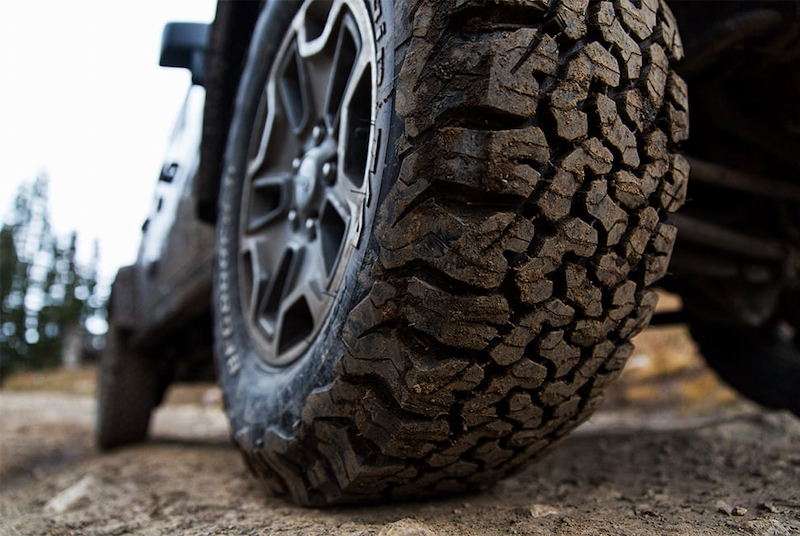The way most vehicles are set up nowadays involves sending power to the front wheels. But there are vehicles that have the rear wheels drive the car and others that have all 4 wheels turn when you start to accelerate. These are known as 4×4 or four-wheel drive cars. The main benefit of 4×4 vehicles is that they offer better traction no matter the road conditions especially when paired with the right tyres.
Having this advantage alone means you can not only climb up hills more easily but you can also take on sharp corners with a lot more speed. Keep in mind that this drivetrain makes for a lot heavier of a vehicle. This is why getting the right tyres can make a big difference.
Types of 4×4 Tyres

All-Terrain
If you go for an all-terrain 4WD tyre you can expect to use them for the whole year no matter the type of terrain you’re going to drive on the most. This is because all-terrain 4WD tyres are made to provide an overall balanced experience no matter if it’s on the smooth tarmac or a rough beaten path.
Mud-Terrain
MT or mud terrain 4×4 tyres are much like all-terrain tyres except that they are mainly made for off-road conditions. As you’d expect they can handle loads of mud as their tread doesn’t let it stick as much. You can also expect MT tyres to get rid of rocks and debris quite easily offering better traction than AT tyres. The thick sidewalls of MT tyres also make for a puncture-resistant four wheel drive tyre.
Highway-Terrain
If you want your 4×4 vehicles to have a smoother and quieter driving experience then you should go for highway-terrain since they are made for the tarmac. Thanks to their more compact tread blocks they make less noise which coupled with added sipes makes it have good traction too. HT tyres are better on damp asphalt than both MT and AT tyres.
Cross-Terrain
CT or cross-terrain tyres are similar to all-terrain tyres since they too can perform well on different terrain. The difference here is that CT tyres are made to perform equally well on both the road and off of it while AT tyres are made more for on-road driving rather than off-roading.
What Matters in a 4×4 Tyre

Heat
Tyres are the only component of your vehicle that is constantly in contact with the road. This is why when travelling at high speeds and braking too there can be a lot of heat in them as there is a lot of friction. Therefore you should go for a 4WD tyre that has a higher temperature rating. They start from A to C and the further down the alphabet the lower the rating.
Traction
The same can be said for traction levels as the closer you get to “A” the higher the traction you get on a four wheel drive tyre. Keep in mind that traction levels start from “AA” and go to “C” which is the most track-ready tyre you can go for.
Treadwear
There are numbers on the sidewall of every tyre including a 4WD tyre and one of them tells you how long the tyre’s tread will last. All you need to know is that the higher this number is the longer the tread will stay on the tyre without it losing traction as easily as a semi-slick tyre.
Prolong the Lifespan of 4×4 Tyres

Alignment
It’s paramount that no matter the type of car you have or the wheels, you need to bring them in for wheel alignment. This should happen about every 6 months to a year or every 10,000 km. This will depend on the the type of driving you do and how frequently you do it and it will prevent premature tread wear and improve stability too.
Rotation
Another preventative measure that can help make your tyre lose less tread but also last longer is to rotate your tyres. This means changing their placement from back to front every 8,000 to 12,00 km if you’ve got HT or AT tyres. But if you have HT tyres on your 4×4 you’ll need to rotate them about every 5,000 km.
Pressure
Something that we all take for granted is air especially the one in our tyres. Having the correct tyre pressure is a must at all times especially when you’re driving across different terrain. Every type of terrain requires different tyre pressures for optimal performance. For example, hotter and rougher terrain requires you to take air out of your tyre while smooth surfaces that are not going to make you slide require having a bit more air in your tyres. But if you’re driving on wet tarmac you’ll want to lower tyre pressure a bit for better traction.
Conclusion
Since 4×4 vehicles are heavier than two-wheel drive vehicles they need tyres that will take more beating. When looking for 4WD tyres remember that you shouldn’t skimp on a thicker and wider sidewall or higher tread rating. You’re better off spending more for a set of tyres rather than repairs later on.
